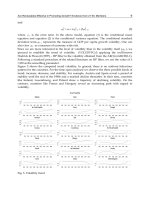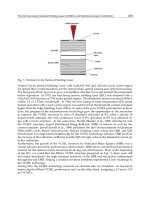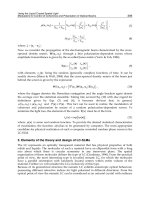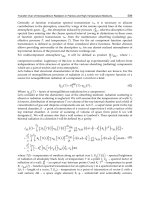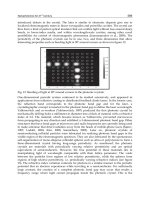Superconductivity Theory and Applications Part 7 docx
Bạn đang xem bản rút gọn của tài liệu. Xem và tải ngay bản đầy đủ của tài liệu tại đây (1.14 MB, 25 trang )
Effects of Impurities on a Noncentrosymmetric Superconductor - Application to CePt
3
Si
139
Application of these results to real noncentrosymmetric materials is complicated by the lack
of definite information about the superconducting gap symmetry and the distribution of the
pairing strength between the bands.
As far as the pairing symmetry is concerned, there is strong experimental evidence that the
superconducting order parameter in CePt
3
Si has lines of gap nodes (Yasuda et al., 2004;
Izawa et al., 2005; Bonalde et al., 2005). The lines of nodes are required by symmetry for all
nontrivial one-dimensional representations of
4v
C (
2
A ,
1
B , and
2
B ), so that the
superconductivity in CePt
3
Si is most likely unconventional. This can be verified using the
measurements of the dependence of
c
T
on the impurity concentration: For all types of
unconventional pairing, the suppression of the critical temperature is described by the
universal Abrikosov-Gor’kov function, see Eq. (32).
It should be mentioned that the lines of gap nodes can exist also for conventional pairing
(
1
A representation), in which case they are purely accidental. While the accidental nodes
would be consistent with the power-law behavior of physical properties observed
experimentally, the impurity effect on
c
T
in this case is qualitatively different from the
unconventional case. In this case in the absence of magnetic impurities one obtains the
following equation for the critical temperature:
0
11 1
ln
24 2
c
ccn
T
TT
(43)
In the low
1
nc
T
and dirty
0
1
nc
T
limit of impurity concentration one has
00
1
8
cc c
n
TT T
(44)
1
0
00
1
nc
cc c
C
T
TT T
e
(45)
This means that anisotropy of the conventional order parameter increases the rate at which
c
T
is suppressed by impurities. Unlike the unconventional case, however, the
superconductivity is never completely destroyed, even at strong disorder.
4. Low temperature magnetic penetration depth of a superconductor without
inversion symmetry
To determine the penetration depth or superfluid density in asuperconductor without
inversion symmetry one calculates the electromagnetic response tensor
,,
s
K
q
vT
, relating
the current density
J
to an applied vector potential A
,,
s
Jq KqvTAq
(46)
The expression for the response function can be obtained as
2
2
,
2
ˆ
,,, 1 , , ,
sm n nm
nk
ne
KqvT T k k k
mc m
(47)
Superconductivity – Theory and Applications
140
where
2
q
kk
,
2
ˆ
k
is the direction of the supercurrent and represents a Fermi
surface average.
By using the expression of Green`s function into Eq. (47) one obtains
2
2
2
,,
2
2
22
22
,,
,,,
.
2
ˆ
1
2
22
sn
nimpsF kk kk
n
nimps k nimps k
ne
KqvT
mc
ivk
Tdk
k
m
ivkEivkE
(48)
Now we separate out the response function as
,, 0,0,0 ,,
ss
K
q
vT K K
q
vT
(49)
where
2
0,0,0
40
c
K
(
1
2
2
2
0
4
mc
ne
is the zero temperature London penetration
depth).
Doing the summation over Matsubara frequencies for each band one gets
2
2
,
2
2
22
0
2
22
,,
2
2
,
2
2
22
,,
2
ˆ
,, Re
.
2
2
2
ˆ
Re
.
2
sF sF k
s
F
imp k k k imp
sF sF k
F
imp k k
fvkf vk
ne
KqvT k d
mc
qk
igi
m
fvkf vk
ne
kd
mc
qk
i
m
,
2
2
0
2
1
2
,
2
22
,,,
2
2
2
,
2
2
.
sinh
2
ˆ
12
2
1
22
2
1
22
ˆ
ln
k
kimp
F
k
FFk
kkk
FF
k
gi
qk
m
ne
k
mc
qk qk g
mm
qk qk g
mm
k
,
,
22
2
,22
,,,
22
2
2
,, ,
4
1
22
.
2 .
1
22 2
k
k
kk
kFF
imp imp
kkk
F
FFk F
imp
kk k
mg
qk qk
mm
qk
qk qk g qk
mm m
,
2
2
,22
,
2
2
22
2
22
,,
4
.
1
2
.
ˆ
2Re
.
2
2
k
kk
F
imp
k
F
sF sF
F
imp k k k imp
mg
qk
m
qk
fvkfvk
kd
qk
igi
m
(50)
Effects of Impurities on a Noncentrosymmetric Superconductor - Application to CePt
3
Si
141
,
1
2
,
2
22
,,,
22
2
2
,,
2
.
sinh
2
ˆ
12
2
1
22
2 .
1
22
ˆ
ln
k
F
k
FFk
kkk
FFk
imp
kk
qk
m
ne
k
mc
qk qk g
mm
qk qk g qk
mm
k
,
,
2
2
,22
,,
22 2
2
2
,, , ,
4
.
1
22
.
4
2
11
22 2 2
k
k
kk
FF
imp
kk
F
k
FFk FF
imp
kk k k
mg
qk
mm
qk
m
qk qk g qk qk
mm m m
,
2
,22
2
2
22
2
22
,,
.
ˆ
2Re
.
2
2
k
k
imp
F
sF sF
F
imp k k k imp
g
qk
fvkfvk
kd
qk
igi
m
(50)
The factor
k
g
characterizes and quantifies the absence of an inversion center in a crystal lattice.
This is the main result of my work i.e. nonlocality, nonlineary, impurity and
nonsentrosymmetry are involved in the response function. The first two terms in Eq. (50)
represent the nonlocal correction to the London penetration depth and the third represents the
nonlocal and impure renormalization of the response while the forth combined nonlocal,
nonlinear, and impure corrections to the temperature dependence.
I consider a system in which a uniform supercurrent flows with the velocity
s
v
, so all
quasiparticles Matsubara energies modified by the semiclassical Doppler shift .
sF
vk
.
The specular boundary scattering in terms of response function can be written as (Kosztin &
Leggett, 1997)
2
2
0
0
,,
2
1
spec
s
T
K
q
vT
dq
q
(51)
In the pure case there are four relevant energy scales in the low energy sector in the
Meissner state: T,
nonlin
E ,
nonloc
E , and
k
g
. The first two are experimentally controlled
parameters while the last two are intrinsic one.
In low temperatures limit the contribution of the fully gap (
0
sin
) Fermi surface I
decrease and the effect of the gap
0
sin
Fermi surface II is enhanced. I consider
geometry where the magnetic field is parallel to c axis and thus
s
v
and the penetration
direction
q
are in the ab plane, and in general,
s
v
makes an angle
with the axis. There are
two effective nonlinear energy scales
1
nonlin s F l
Evku
and
2
nonlin s F l
Evku
.where
cos sin
l
ul
and
12
,1ll
.
In the nonlocal
0q
, linear
0
s
v limit, i.e., in the range of temperature where
nonlin nonloc
ETE one gets
2
0
0
3
2
222
0
00
2ln2
4
,0,
3
3
42
4
l
l
l
ll
l
cT
wT
Kq T
w
cT
uwT
w
(52)
Superconductivity – Theory and Applications
142
where sin cos
l
wl
, sin
l
ucosl
, and 2
22
F
k
qv
g
.
Depending on the effective nonlocal energy scales
12
12
00
,,,1
Fl Fl
nonloc nonloc
vu vu
EEll
one obtains
0
2
,
,
nonloc nonloc
spec
nonloc nonloc
nonloc nonloc
TEET
T
TETE
TEET
(53)
For CePt
3
Si superconductor with
0.75
c
TK
, the linear temperature dependence would
crossover to a quadratic dependence below 0.015
nonloc
TK
.
Magnetic penetration depth measurements in CePt3Si did not find a
2
T law as expected for
line nodes. I argue that it may be due to the fact that such measurements were performed
above 0.015K. On the other hand, it is note that CePt3Si is an extreme type-II
superconductor with the Ginzburg-Landau parameter, 140K
, and the nonlocal effect can
be safely neglected, and because this system is a clean superconductor, neglect the impurity
effect can be neglected (Bauer et al., 2004; Bauer et al., 2005).
In the local, clean, and nonlinear limit
0, 0
s
qv the penetration depth is given by
1
2
40,,
loc
spec
s
c
Kq v T
(54)
Where
1
2
,
22
2
2
22 22 2
,,
,,
1
2
2
,,
.
sinh
2
ˆˆ
12 2 Re
2
.
2
1
2
.
sinh
ˆ
12
s
F
sF sF
k
kk k
F
F
kk
F
KqvT
qk
fvkfvk
m
ne
kkd
mc
g
qk
k
m
qk
ne
k
mc
,
2
2
2
22 2 2
,,
,,
2
ˆ
2Re
2
.
2
1
2
sF sF
k
kk k
F
F
kk
fvkfvk
m
kd
g
qk
k
m
(55)
Thus by considering only the second term in the right hand side of Eq. (55) into Eq. (51) one
gets
Effects of Impurities on a Noncentrosymmetric Superconductor - Application to CePt
3
Si
143
1
2
2
0
1
3
2
0000
3
4
00
2
1
ln2 ,
2
2
1
ln2
22
22
2
1
22
,
2
sF k
l nonlin nonlin
l
spec
l
k
sF
l nonlin nonlin
k
sF
vk g
l
l
T
nonlin nonlin
T
uEET
u
g
vk
T
uETE
g
vk
u
oTe E E T
(56)
The linear temperature dependence of penetration depth is in agreement with Bonalde et
al's result (Bonalde et al., 2005).
Thus the
T behavior at low temperatures of the penetration depth in Eq. (56) is due to
nonlineary indicating the existence of line nodes in the gap parameter in CePt
3
Si compound.
A
T linear dependence of the penetration depth in the low temperature region is expected
for clean, local and nonlinear superconductors with line nodes in the gap function.
Now the effect of impurities when both s-wave and p-wave Cooper pairings coexist is
considered.
I assume that the superconductivity in CePt
3
Si is unconventional and is affected only by
nonmagnetic impurities. The equation of motion for self-energy can be written as
,,,
nn n
imp n
pi nT pp i
(57)
where the T matrix is given by
3
3
,,
1,,
n
n
u
Tppi
uppi
(58)
here
3
is the third Pauli-spin operator.
By using the expression of the Green’s function in Eq. (58) one can write
0
2
0
2
00
,,
1
n
NuI
Tppi
NuI
(59)
where
2
1
2
2
0
4
imp n
imp n
i
d
I
i
(60)
and
0
u is a single s-wave matrix element of scattering potential
u
.Small
0
u puts us in the
limit where the Born approximation is valid, where large
00
uu
, puts us in the
unitarity limit.
Superconductivity – Theory and Applications
144
Theoretically it is known that the nodal gap structure is very sensitive to the impurities. If
the spin-singlet and triplet components are mixed, the latter might be suppressed by the
impurity scattering and the system would behave like a BCS superconductor. For p-wave
gap function the polar and axial states have angular structures,
0
cos
kk
TT
and
0
sin
kk
TT
respectively. The electromagnetic response now depends on the mutual
orientation of the vector potential
A and
ˆ
I (unit vector of gap symmetry), which itself may
be oriented by surfaces, fields and superflow. A detailed experimental and theoretical study
for the axial and polar states was presented in Ref. (Einzel, 1986). In the clean limit and in
the absence of Fermi-Liquid effects the following low-temperature asymptotic were
obtained for axial and polar states
,
,
,
0
0
n
B
T
kT
a
(61)
where in the axial state
24n and
4
2
7
15
a
, and in the polar state
31n and
27 3
3ln2
42
a
, for the orientations
.
The influence of nonmagnetic impurities on the penetration depth of a p-wave
superconductor was discussed in detail in Ref (Gross et al., 1986). At very low temperatures,
the main contribution will originated from the eigenvalue with the lower temperature
exponent n, i.e., for the axial state (point nodes) with
2
T low, and for the polar state (line
nodes) the dominating contribution with a linear
T . The quadratic dependence in axial state
may arise from nonlocality.
The low temperature dependence of penetration depth in polar and axial states used by
Einzel et al., (Einzel et al. 1986) to analyze the
2
TT
behavior of Ube
13
at low
temperatures. The axial
ˆ
AI
case seems to be the proper state to analyze the experiment
because it was favored by orientation effects and was the only one with
2
T dependence.
Meanwhile, it has turned out that
2
T behavior is introduced immediately by T-matrix
impurity scattering and also by weak scattering in the polar case. The axial sate., and
according to the Andersons theorem the s-wave value of the London penetration depth are
not at all affected by small concentration of nonmagnetic impurities.
Thus, for the polar state, Eq. (60) can be written as
2
1
2
2
0
22
0
2
imp n
imp n
i
d
I
icos
(62)
Doing the angular integration in Eq. (62) and using Eqs. (57) and (59) one obtains
Effects of Impurities on a Noncentrosymmetric Superconductor - Application to CePt
3
Si
145
2
222
0
00
22
0
2
222 2 2 2
0
00
22
0
20 /
14(0) /
n
imp n
Nnu K
Nu K
(63)
here
K
is the elliptic integral and
im
p
n
i
. We note that in the impurity dominated
gapless regime, the normalized frequency
takes the limiting form i
, where
is
a constant depending on impurity concentration and scattering strength.
In the low temperature limit we can replace the normalized frequency
everywhere by its
low frequency limiting form and after integration over frequency one gets
2
222
2
1
5
22
2
4
ˆ
,,
3
k
s
k
Ne T
KqvT k
mc
(64)
As in the case of d-wave order parameter, from Eqs. (64) and (51) one finds
2
0
00
4
ln
04 24
T
T
(65)
In
p-wave cuprates, scattering fills in electronic states at the gap nodes, thereby suppressing
the penetration depth at low temperatures and changing
T -linear to
2
T
behavior.
5. Effect of impurities on the low temperature NMR relaxation rate of a
noncentrosymmetric superconductor
I consider the NMR spin-lattice relaxation due to the interaction between the nuclear spin
magnetic moment
n
I
(
n
is the nuclear gyro magnetic ratio) and the hyperfine field h,
created at the nucleus by the conduction electrons. Thus the system Hamiltonian is
0intso n
HH H H H
(66)
where
0
H and
so
H are defined by Eqs. (1) and (2),
nn
HIH
is the Zeeman coupling of
the nuclear spin with the external field
H
, and
int n
HIh
is the hyperfine interaction.
The spin-lattice relaxation rate due to the hyperfine contact interaction of the nucleus with
the band electron is given by
2
0
1
Im
1
lim
2
R
J
R
TT
(67)
where
is the NMR frequency,
8
3
ne
J
(
e
is the electron geomagnetic ratio) is the
hyperfine coupling constant, and
R
, the Fourier transform of the retarded correlation
Superconductivity – Theory and Applications
146
function of the electron spin densities at the nuclear site, in the Matsubara formalism is
given by (in our units
1
B
k
)
0
R
TS S
(68)
here
T
is the time order operator,
is the imaginary time,
HH
SeSe
, and
†
Sr r r
†
Sr r r
(69)
with
†
r
and
r
being the electron field operators.
The Fourier transform of the correlation function is given by
0
n
i
RR
n
ide
(70)
The retarded correlation function is obtained by analytical continuation of the Matsubara
correlation function
n
RR
n
ii
i
.
From Eqs. (66)- (70), one gets
2
0
1
,,
11
lim
2
Im , , , ,
ii
n
n
nm n nm n
pp
J
TT
T Trpii pi TrFpiiFpi
(71)
where 2
m
mT
are the bosonic Matsubara frequencies. By using Eqs. (11) and (12) into
Eq. (71), the final result for the relaxation rate is
2
1
0
1
f
Jd N N M M
TT
(72)
where
1
1
T
fe
is the Fermi Function.,
N
and
M
defined by the
retarded Green’s factions as
,
Im ,
R
p
Np
(73)
,
Im ,
R
p
MFp
(74)
In low temperatures limit the contribution of the fully gap (
0
sin
) Fermi surface I
decrease and the effect of the gap
0
sin
Fermi surface II is enhanced.
Effects of Impurities on a Noncentrosymmetric Superconductor - Application to CePt
3
Si
147
As I mentioned above, the experimental data for CePt3Si at low temperature seem to point
to the presence of lines of the gap nodes in gap parameter (In our gap model for
0
,
0
sin
has line nodes). Symmetry imposed gap nodes exist only for the order
parameters which transform according to one of the nonunity representations of the point
group. For all such order parameters
0M
.Thus, Eq. (72) can be written as
2
2
1
0
1
4
cos
2
Jd
NN
TT T
h
T
(75)
In the clean limit the density of state can be calculated from BCS expression
0
22
ReNN
(76)
For the gap parameter with line nodes from Eq. (76) one gets
0
0
2
NN
(77)
Thus from Eq. (75) one has
22 23
0
2
1
0
1
2
JNT
T
(78)
Therefore, line nodes on the Fermi surface II lead to the low-temperature
3
T law in
1
1
T
which is in qualitative agreement with the experimental results.
In the dirty limit the density of state can be written as
22
0
,
1,
BCS
BCS
imp
N
Nd
uN
(79)
In the limit,
0
where
0
imp
n
N
NV
(
N
V
is the electron density) the density of state is
2
0
imp
NNac
(80)
where
0
cotcg
(
0
is the s-wave scattering phase shift), a is a constant, and
0N the
zero energy
0
quasi-particle density of state is given by
Superconductivity – Theory and Applications
148
1
2
2
0
11
1
42
o
NN
(81)
where
.
In the unitary limit
0
u ,0c
0
2
, from Eqs. (75) and (80) one obtains
2
2
1
1
0
JN T
T
(82)
Thus the power-low temperature dependence of
1
1
T
is affected by impurities and it
changes to linear temperature dependence characteristic of the normal state Koringa relation
again is in agreement with the experimental results.
6. Conclusion
In this chapter I have studied theoretically the effect of both magnetic and nonmagnetic
impurities on the superconducting properties of a non-centrosymmetric superconductor and
also I have discussed the application of my results to a model of superconductivity in
CePt3Si.
First, the critical temperature is obtained for a superconductor with an arbitrary of impurity
concentration (magnetic and nonmagnetic) and an arbitrary degree of anisotropy of the
superconducting order parameter, ranging from isotropic s wave to p wave and mixed (s+p)
wave as particular cases.
The critical temperature is found to be suppressed by disorder, both for conventional and
unconventional pairings, in the latter case according to the universal Abrikosov-Gor’kov
function.
In the case of nonsentrosymmetrical superconductor CePt3Si with conventional pairing (
1
A
representation with purely accidental line nodes), I have found that the anisotropy of the
conventional order parameter increases the rate at which
c
T is suppressed by impurities.
Unlike the unconventional case, however, the superconductivity is never completely
destroyed, even at strong disorder.
In section 4, I have calculated the appropriate correlation function to evaluate the magnetic
penetration depth. Besides nonlineary and nonlocality, the effect of impurities in the
magnetic penetration depth when both
s-wave and p-wave Cooper pairings coexist, has
been considered.
For superconductor CePt
3
Si, I have shown that such a model with different symmetries
describes the data rather well. In this system the low temperature behavior of the magnetic
penetration depth is consistence with the presence of line nodes in the energy gap and a
quadratic dependence due to nonlocality may accrue below 0.015
nonloc
TK
. In a dirty
superconductor the quadratic temperature dependence of the magnetic penetration depth
may come from either impurity scattering or nonlocality, but the nonlocality and nodal
behavior may be hidden by the impurity effects.
Effects of Impurities on a Noncentrosymmetric Superconductor - Application to CePt
3
Si
149
Finally, I have calculated the nuclear spin-lattice relaxation of CePt
3
Si superconductor. In
the clean limit the line nodes which can occur due to the superposition of the two spin
channels lead to the low temperature
3
T law in
1
1
T
. In a dirty superconductor the linear
temperature dependence of the spin-lattice relaxation rate characteristic of the normal state
Koringa relation.
7. Acknowledgment
I wish to thank the Office of Graduate Studies and Research Vice President of the
University of Isfahan for their support.
8. References
Abrikosov, A. A. (1993). Influence of the Gap Anisotropy on Superconducting Properties.
Physica C, Vol. 214, No. 1-2, (1 September 1993), pp.107-110, ISSN 0921-4534
Abrikosov, A. A. & Gor'kov, L. P. (1959).On the theory of superconducting alloys.
Soviet
Physics, JETP
, Vol. 8, pp. 1090. ISSN 0038-5654
Abrikosov, A. A. & Gor'kov,L. P. (1961). Contribution to the theory of superconducting
alloys with paramagnetic impurities.
Soviet Physics, JETP, Vol. 12, pp. 1243. ISSN
0038-5654
Abrikosov, A. A; Gor’kov, L. P & Dzyaloshnskii, I. E. (1975).
Methods of Quantum Field Theory
in Statistical Physics
, Dover Publications Inc, ISBN 0486632288, New York.
Akazawa, T; Hidaka, H; Fujiwara, T; Kobayashi, T. C; Yamamoto, E; Haga, Y; Settai, R. &
Onuki, Y. (2004). Pressure-induced Superconductivity in UIr without inversion
symmetry.
Journal of Physics: Condensed Matter, Vol. 16, No. 4, (16 January 2004), pp.
29-32, ISSN 1361-648X
Anderson, P. W. (1959). Theory of dirty superconductors.
Journal of Physics and Chemistry of
Solids,.
Vol. 11, No. 1-2, (September 1959), pp. 26-30,
ISSN 0022-3697
Anderson, P. W. (1984). Structure of triplet superconducting energy gap.
Physical Review
B
, Vol. 30, No.7, (1 October 1984), pp. 4000-4002, ISSN 1550-235X
Bauer, E; Bonalde, I. & Sigrist, M. (2005). Superconductivity and normal state properties of
non-centrosymmetric CePt3Si:a status report.
Low Temp. Phys, Vol. 31, No. 8, (7
October 2005), pp.748-757,
Bauer, E; Hilscher, G; Michor, H; Paul, Ch; Scheidt, E. W; Gribanov, A; Seropegin, Yu; Noël,
H; Sigrist, M. & Rogl, P. (2004). Heavy Fermion Superconductivity and Magnetic
Order in Noncentrosymmetric CePt
3
Si. Physical Review Letters, Vol. 92, No. 2, (13
January 2004), pp.027003 [4 pages], ISSN 1079-7114
Bauer, E; Hilscher, G; Michor, H; Sieberer, M; . Scheidt, E. W; Gribanov, A; Seropegin, Yu;
Rogl, P; Amato, A; Song, W. Y; Park,J. G; Adroja, D. T; Nicklas, M; Sparn, G; Yogi,
M. & Kitaoka, Y. (2005). Unconventional superconductivity and magnetism in
CePt
3
Si
1-x
Ge
x
. Physica B, Vol. 359-361, (30 April 2005 ), Pp. 360-367, ISSN 0921-4526
Blatsky, A.V; Vekhter,I. & Zhu, J.X. (2006). Impurity-induced states in conventional and
unconventional superconductors.
Reviews of Modern Physics, Vol. 78, No. 2, (9
May2006), pp.373–433, ISSN 1539-0756
Superconductivity – Theory and Applications
150
Bonalde,I; Brämer-Escamilla, W. & Bauer, E. (2005). Evidence for Line Nodes in the
Superconducting Energy Gap of Noncentrosymmetric CePt
3
Si from Magnetic
Penetration Depth Measurements
. Physical Review Letters, Vol. 94, No. 20, (23 May
2005), pp.207002 [4 pages], ISSN 1079-7114
Borkowski, L. S; & Hirschfeld, P. J. (1992). Kondo effect in gapless superconductors.
Physical
Review B,
Vol.46, No.14, (1 October 1992), pp.9274–9277, ISSN 1550-235X
Borkowski, L. S; & Hirschfeld, P. J. (1994). Distinguishing
d-wave superconductors from
highly anisotropic
s-wave superconductors. Physical Review B, Vol. 49, No. 21, (1
June 1994 ), pp.15404–15407, ISSN 1550-235X
Dresselhaus, G. (1955). Spin-Orbit Coupling Effects in Zinc Blende Structures.Phys. Rev. 100,
580.
Physical Review, Vol.100, No.2, (15 October1955), pp.580–586,
Einzel, D; Hirschfeld, P. J; Gross, F; Chandrasekhar, B.S; Andres, K; Ott, H R; Beuers, J;
Fisk, Z. & Smith, J.L. (1986). Magnetic Field Penetration Depth in the Heavy-
Electron Superconductor UBe
13
. Physical Review Letters, Vol. 56, No. 23, (9 June
1986), pp.2513–2516, ISSN 1079-7114
Edelstein, V. M. (1995). Magnetoelectric Effect in Polar Superconductors.
Physical Review
Letters,
Vol. 75, No 4, (4 September 1995), pp. 2004–2007, ISSN 1079-7114
Frigeri, P. A; Agterberg, D.F. & Sigrist,M. (2004). Spin susceptibility in superconductors
without inversion symmetry.
New Journal of Physics, Vol.6, No.1, (2 September
2004), pp.115 [9 pages],
ISSN 1367-2630
Frigeri, P. A; Agterberg; D. F; Koga, A. & Sigrist, M. (2004). Superconductivity without
Inversion Symmetry: MnSi versus CePt
3
Si. Physical Review Letters, Vol.92, No. 9, (3
March 2004), pp.097001 [4 pages], ISSN 1079-7114
Gor’kov, L. P & Rashba, E. I. (2001). Superconducting 2D System with Lifted Spin
degeneracy: Mixed Singlet-Triplet State.
Physical Review Letters, Vol. 87, No. 3,
(16July 2001), pp.037004 [4 pages], ISSN 1079-7114
Gross, F; Chandrasekhar, B.S; einzel,D; Andres, K; Herschfeld, P.J; Ott, H.R; Beuers, J; Fisk,
Z. & Smith, J.L. (1986). Anomalous temperature dependence of the magnetic field
penetration depth in superconducting UBe
13
. Zeitschrift für Physik B: Condensed
Matter
, Vol. 64, No. 2, pp.175-188, ISSN 0722-3277
Hayashi, N; Wakabayashi, K; Frigeri, P. A. & Sigrist1, M. (2006). Nuclear magnetic
relaxation rate in a noncentrosymmetric superconductor.
Physical Review B, Vol. 73,
No. 9, (17 March 2006), pp.092508 [4 pages], ISSN 1550-235x
Hayashi, N; Wakabayashi, K; Frigeri, P. A. & Sigrist, M. (2006). Temperature dependence of
the superfluid density in a noncentrosymmetric superconductor.
Physical Review B,
Vol. 73, No. 2, (19 January 2006), pp. 024504[9 pages], ISSN 1550-235X
Izawa,K; Kasahara, Y; Matsuda,Y; Behnia,K; Yasuda,T; Settai,R. & Onuki,Y. (2005) Line
Nodes in the Superconducting Gap Function of Noncentrosymmetric CePt
3
Si.
Physical Review Letters, Vol. 94, No. 19, (16 May 2005), pp.197002 [4 pages], ISSN
1079-7114
Kosztin, I & Leggett, A.J. (1997) Nonlocal Effects on the Magnetic Penetration Depth in
d-
Wave Superconductors.
Physical Review Letters, Vol. 79, No. 1, (7 July 1997), pp.135–
138, ISSN 1079-7114
Effects of Impurities on a Noncentrosymmetric Superconductor - Application to CePt
3
Si
151
Mathur, N.D; Grosche, F. M; Julian S. R; Walker, I. R; Freye, D. M; Haselwimmer R. K. W &
Lonzarich G. G. (1998). Magnetically mediated superconductivity in heavy rmion
compounds .
Nature, Vol. 394, (2 July 1998), pp.39-43 ISSN 0028-0836
Mineev, V. P. & Samokhin, K. V. (2007). Effects of impurities on superconductivity in
noncentrosymmetric compounds.
Physical Review B, Vol.75, No. 18, (25 May 2007),
pp.184529 [14 pages], ISSN
1550-235X
Mineev, V. P. & Champel, T. (2004) Theory of superconductivity in ferromagnetic
superconductors with triplet pairing. Phys.
Physical Review B, Vol. 69, No. 14, (27
April 2004),pp.144521 [6 pages], ISSN
1550-235X
Rashba,E. I. (1960). Properties of Semiconductors with an Extremum Loop I. Cyclotron and
Combinatorial Resonance in a Magnetic Field Perpendicular to the Plane of the
Loop.
Soviet Physics—Solid State, vol. 2, (Jun. 1960), pp. 1109-1122, ISSN 0038-5654.
Rashba,E. I & Bychkov, Yu. A. (1984). Oscillatory effects and the magnetic susceptibility of
carriers in inversion layers.
Journal of Physics C: Solid State Physics, Vol. 17, No. 33,
(30 November 1984
), pp.6039-6045, ISSN 0022-3719
Salkalo, M.I; Balatsky,A.V. & Scalapino,D.J. (1996) Theory of Scanning Tunneling
Microscopy Probe of Impurity States in a
D-Wave Superconductor. Physical Review
Letters,
Vol. 77, No. 9, (26 August 1996), pp.1841–1844, ISSN 1079-7114
Samokhin, K. V; Zijlstra,E. S; & Bose, S. K. (2004). CePt
3
Si: An unconventional
superconductor without inversion center.
Physical Review B, Vol. 69, No. 9, (19
March 2004), pp. 094514 [8 pages], ISSN 1550-235X
Saxena, S. S; Agarwal, P; Ahilan, K; Grosche, F. M; Haselwimmer, R. K. W; Steiner, M. J;
Pugh, E; Walker, I. R; Julian, S. R; Monthoux, P; Lonzarich, G. G; Huxley, A;
Sheikin, I Braithwaite D & Flouquet, J. (2000). Superconductivity on the border of
itinerant-electron ferromagnetism in UGe
2
. Nature, Vol. 406, No. 6796, (10 August
2000), pp
.587-592, ISSN 0028-0836
Sergienko, I. A. & Curnoe, S. H. (2004). Order parameter in superconductors with
nondegenerate bands.
Physical Review B, Vol.70, No. 21, (7 December 2004),
pp.214510 [8 pages], ISSN 1550-235X
Sergienko, I. A. (2004). Mixed-parity superconductivity in centrosymmetric crystals,
Physical Review B, Vol. 69, No. 17, (18 May 2004), pp.174502 [5 pages], ISSN 1550-
235X
Shiba,H. (1968). Classical Spins in Superconductors.
Progress of Theoretical Physics, Vol. 40,
No. 3 (12 April 1968), pp. 435-451, ISSN 1347-0481
Wang, Q.H. & Wang, Z.D. (2004). Impurity and interface bound states in
d
x
2
-y
2
+id
xy
and
p
x
+ip
y
superconductors. Physical Review B, Vol. 69, No. 9, (10 March 2004),
pp.092502 [4 pages], ISSN 1550-235X
Yasuda, T; Shishido, H; Ueda,T; Hashimoto, S; Settai, R; Takeuchi,T; Matsuda,T. D; Haga, Y.
& Onuki,Y. (2004). Superconducting Property in CePt
3
Si under Pressure. Journal of
the Physical Society of Japan
, Vol. 73, No. 7, (13 April 2004) pp. 1657-1660, ISSN: 1347-
4073
Yogi, M; Kitaoka,Y; Hashimoto,S; Yasuda, T; Settai,R; Matsuda, T. D; Haga,Y; Onuki, Y;
Rogl, P. & Bauer,E. (2004). Evidence for a Novel State of Superconductivity in
Superconductivity – Theory and Applications
152
Noncentrosymmetric CePt
3
Si: A
195
Pt-NMR Study. Physical Review Letters,Vol. 93,
No. 2, (8 July 2004), pp.027003 [4 pages], ISSN
1079-7114
Yogi, M; Kitaoka,Y; Hashimoto, S; Yasuda, T; Settai, R; Matsuda, T. D; . Haga, Y; Onuki, Y;
Rogl, P. & Bauer, E. (2005). Novel superconductivity in noncentrosymmetric heavy-
fermion compound CePt
3
Si: a
195
Pt-NMR study. Physica B,Vol.359-361, (30 April
2005), pp. 389-391. ISSN
0921-4526
8
Foundations of Meissner Superconductor
Magnet Mechanisms Engineering
Jose Luis Perez-Diaz and Efren Diez-Jimenez
Dpt. Ingeniería Mecánica – Universidad Carlos III de Madrid
Spain
1. Introduction
It has long been known that a repulsive force arises between a magnetic field (generated,
for instance, by a permanent magnet - PM) and a superconductor –Sc (Arkadiev, 1947).
This force is due to the repulsion of the magnetic field away from the superconductor –
the Meissner effect. Type I superconductors only can be in the Meissner state, which
means that a magnetic field will be always expelled from the superconductor,
independently of its poles orientation. Nevertheless, type II superconductors may be in
two different states: first, provided the magnetic field is low enough, they are at a
Meissner state similar to type I superconductors. In this Meissner state they absolutely
expel the magnetic field and prevalent repulsive forces appear. Second, for magnetic
fields larger than the so-called First Critical Field H
C1
, the magnetic flux penetrates the
superconductor creating a magnetization which contributes to an attractive resulting
force. This second state is known as mixed state.
In 1953 Simon first tried to make a superconducting bearing (Simon, 1953) using
superconductors in the mixed state.The first engine using a superconducting bearing was
made in 1958 (Buchhold, 1960). After the discovery of high critical temperature
superconductors (Bednorz & Müller, 1986), the Meissner repulsive force has become a
popular way of demonstrating superconducting properties (Early et al., 1988).For
calculating forces between a magnet and a superconductor it is necessary to have models
that describe both the flux penetration state and the Meissner state repulsion. The first one
can be solved by using conventional methods to compute forces between magnetic elements
and magnetized volumes. However, for the Meissner state the question has remained open
until these last years.
Several models using the method of images to calculate superconducting repulsion forces
(Lin, 2006; Yang & Zheng, 2007) have been proposed. However, this method of images is
limited to a few geometrical configurations that can be solved exactly, and the physical
interpretation of the method is under discussion (Giaro et al., 1990; Perez-Diaz & Garcia-
Prada, 2007). Furthermore, some discrepancies within experiments still exist (Hull, 2000).
A general local model based on London’s and Maxwell’s equations has been developed to
describe the mechanics of the superconductor-permanent magnet system (Perez-Diaz et al.,
2008). Due to its differential form, this expression can be easily implemented in a finite
elements analysis (FEA) and is consequently appliable to any shape of superconductor in
pure Meissner state (Diez-Jimenez et al. 2010).
Superconductivity – Theory and Applications
154
In this chapter, we present the demonstration of the model, the implementation into a finite
elements program, the experimental verification and its limit of application. To finish, we
show an example of usage.
2. Magneto-mechanics of a superconductor in Meissner state
A superconductor is in a pure Meissner state when it is exposed to an externally applied
magnetic field,
a
p
H
, lower than a certain value, H
C1
. H
C1
is a characteristic of the material
(Alario & Vincent, 1991), which depends on temperature. In this case, it is assumed that both
H
and B
are equal to zero inside the superconductor. When a magnetic field is then
applied –for example by moving a permanent magnet close to the superconductor - a
surface current density is generated on the outermost surfaces. According to the London
equation, this current is confined only to a depth of λ(T). Type II superconductors, such as
the rare earth oxide high temperature superconductors, have the highest values for λ,
reaching typical values of thousands of Amstrongs (Umezawa & Crabtree, 1998). Therefore,
as this paper deals with macroscopic elements, it can be approximated that current density
has an infinitely localized surface current
(,)()
s
J
j
x
y
z
(1)
where ( , )
s
j
x
y
is a surface current density tangent to the surface vector field and
()z
is a
Dirac delta function on
z. This current density will make H
discontinuous when passing
from the air or vacuum (
z>0) into the superconductor (z<0).The second Maxwell law
(Jackson, 1975) relates the magnetic field and the current density in such a way that ( , )
s
jxy
is determined by
a
p
H
.Using units from the MKSA system, this second Maxwell law can be
written as
D
Hj
t
(2)
In the static limit it can be assumed that 0
D
t
. Therefore it may simply be written as:
HJ
(3)
H
may be decomposed in that externally applied
a
p
H
and that generated by the
superconducting currents
sc
H
. Furthermore, these three vector fields will be decomposed
both in tangent and normal to the surface components:
// //
//
ap
sc
HHH
(4)
and
ap
sc
HH H
(5)
Foundations of Meissner Superconductor Magnet Mechanisms Engineering
155
Note that
a
p
H
is continuous and fulfils:
0
ap
H
, provided the permanent magnet does
not touch the superconductor surface. On the contrary, both
H
and
sc
H
are discontinuous
at the superconducting surface. In particular, both
//
H and
//
sc
H are discontinuous.
By using the divergence theorem (Jackson, 1975) on a small parallelepiped with volume V, a
face just above the superconductor surface and another parallel face under it, it can be
written that:
3
s
VS
Hdx n HdS
(6)
where S is the surface defining this parallelepiped and
S
n its normal vector. By using
Maxwell law (3) it can be reduced to:
3
s
VS
Jdx n HdS
(7)
But, taking (1) into account, and considering
0H
under the superconducting surface it
can be written that:
//ss
SS
jdS n H dS
(8)
where
//
H
is evaluated at z=0
+
(limit above the superconductor surface).
As this result is independent of the small parallelepiped previously chosen, the integrands
must equal:
//
(0)
ss
jnHz
(9)
Furthermore,
//
(0)0Hz
and
// //
(0) (0)
sc sc
Hz Hz
implies:
//
//
(0) (0)
ap
sc
Hz Hz
(10)
Therefore, an expression for the superconducting current as a function of the applied
magnetic field may be written:
//
22
a
p
a
p
ss s
jnH nH
(11)
All expressions shown use the MKS unit system.
Applying the divergence theorem clearly shows that the total charge is always conserved,
for whichever surface shape the superconductor has, provided the source of the applied
field is outside the superconductor:
3
20
ap ap
ss
SS V
jdS n H dS H dx
(12)
Furthermore,
0
ap
sc
HH H
(13)
Superconductivity – Theory and Applications
156
which is consistent with the previous expression for the superconducting current.
The total field thus generated for a semi-infinite plane is equivalent to that generated by the
method of images (Cansiz & Hull, 2005; Hellman et al. 1988; Hull & Cansiz, 1999; Moon,
1994). As the expression (11) has been derived using only local arguments, it may be used
for any shape of superconductor. It does not depend on the curvature of the surface.
2.1 Force calculation
The external force (by unit surface) experienced by the superconductor can be calculated by
using Lorentz force.
a
p
s
dF
jB
dS
(14)
Using the previous expression for the superconducting current (1) and the constituent
equation of air (15) (the medium in which the field is generated)
0
a
p
a
p
BH
(15)
it can be written that:
0
2( )
ap
a
p
s
dF
nH H
dS
(16)
This is a local and exact expression for the “pressure” or more precisely “stress” or force per
unit surface on the superconductor, which depends only on the applied magnetic field. It is
useful for any shape of superconductor. This differs fundamentally from the general
expression used to calculate the magnetic stress between magnetic materials as given by
Moon.
According to Newton’s law, the force exerted by the superconductor on the magnet is
simply the opposite one. Therefore, for any shape of superconductor, the force exerted by
the superconductor on the magnet can be written as:
0
2( )
ap
ap
s
Sc
FnHHdS
(17)
where the integration extends over the whole surface of the superconductor.
2.2 Torque calculation
The torque suffered by the superconductor can easily be deduced as :
0
(2 ( ) )
ap ap
Sc s
Sc
M
rnHHdS
(18)
where r
is the position vector between the differential surface element and the center of
mass of the superconductor bulk. Again, the integration extends over the whole surface of
the superconductor.
In order to calculate the moment applied over the magnet, the
PM
r
must be the position
vector between the differential surface element and the center of mass of the permanent
magnet. As noted previously, the force exerted by the superconductor on the external
Foundations of Meissner Superconductor Magnet Mechanisms Engineering
157
magnetic field (in this case a single permanent magnet) is simply the opposite one, and the
same applies for the torque.
0
(2 ( ) )
ap ap
PM PM s
Sc
M
rnHHdS
(19)
3. Finite elements implementation
Due to this differential form equation (16) can be easily implemented in a finite element
program. A FEM algorithm has been adapted for the commercial software ANSYS. The
SURF154 element of ANSYS was used insofar as it has defined a set of useful attributes e.g.
the surface normal direction. The algorithm is valid in the context of a common
electromechanical simulation. The steps for the simulation were:
-
Select Element Type: SOLID98 (with a maximum of one degree of freedom MAG) and
SURF154.
-
Create the different materials to be used. For the superconductor bulk, air properties
were used.
-
Generate the geometries of the volumes for the electromagnetic system.
-
Assign materials’ properties to each volume, selecting air for the superconductor.
-
Mesh the whole system with the SOLID98 element (as fine as is considered adequate -
discussed further below).
-
Mesh the superconductor surface with the SURF154 element.
-
Apply the electromechanical loads to the system.
-
Solve the electromagnetic equation system.
Once the system has been solved, the algorithm can be applied using a Command List. Fig. 1
shows a flow-diagram of the procedure.
This procedure has to be performed for each piece of superconductor in the system. Should
there be more than one piece, a different internal SURF154 element must be created and
accordingly, the number of SURF154 elements in the first step (ESEL) must be changed.
These steps provide the three components of the force vector. The torque applied on the
superconductor can also be calculated, from which the torques values can then be derived.
3.1 Results provide by the post-processing
The algorithm has been tested using one of the most common experiments found in relevant
literature: a permanent magnet oriented vertically over a superconductor pile in any
arbitrary position.
Firstly, an electromagnetic system composed of a small magnet suspended over a
superconducting cylinder was designed, as shown in Fig. 2.
The dimensions of the superconductor were: 20 mm diameter and 7.5 mm height, and the
small magnet was characterized by a coercivity of 875 kA/m and a remanence of 1.18 T,
with a 3.5 mm diameter and a 2 mm height. The magnet’s centroid was placed 10 mm over
the surface of the superconductor. The entire system was placed in surroundings measuring
100x100x100 mm.
The results that can be obtained are the distribution of forces, torque and current densities
per surface element. In fig 3, these distributions for an arbitrary position of the magnet over
the superconductor are shown.
Superconductivity – Theory and Applications
158
Fig. 1. Flow-diagram of the algorithm.
Fig. 2. Small permanent magnet (m=0.016 Am2) over superconductor.
Foundations of Meissner Superconductor Magnet Mechanisms Engineering
159
Fig. 3. Force, torque and current density distributions per surface element.
1
.157E-08
.157E-04
.314E-04
.471E-04
.628E-04
.785E-04
.942E-04
.110E-03
.126E-03
.141E-03
JUL 14 2010
17:33:09
VECTOR
STEP=1
SUB =1
TIME=1
FX
ELEM=1458
MIN=.157E-08
MAX=.141E-03
1
.353E-10
.103E-06
.206E-06
.308E-06
.411E-06
.514E-06
.617E-06
.720E-06
.822E-06
.925E-06
JUL 14 2010
17:39:10
VECTOR
STEP=1
SUB =1
TIME=1
MX
ELEM=1459
MIN=.353E-10
MAX=.925E-06
1
3.865
669.99
1336
2002
2668
3334
4001
4667
5333
5999
JUL 14 2010
17:15:56
VECTOR
STEP=1
SUB =1
TIME=1
JX
NODE=137
MIN=3.865
MAX=5999
Superconductivity – Theory and Applications
160
The same simulation was repeated several times with different meshes, increasing the
number of elements for the whole simulation. Using the parameter α, the fineness of the
mesh can be defined as the ratio between the maximum of the area of the elements and the
total area of the superconductor multiplied by 100.
max (elements areas)
100
total SC area
(3)
Different meshes along with their respective α parameters are shown in fig. 4. The number
of SURF154 elements and the values of the solution are also displayed.
Fig. 4. Different meshes of the superconductor pile.
Fig. 5 shows the relative error of the calculations in relation to the analytical solution (with a
magnetic moment of 0.016 A·m
2
). The higher the number of surface elements, the smaller
the relative error of the result. For example, where α is smaller than 0.1 %, the resulting
relative error is less than 3 %.
Fig. 5. Relative errors of the results vs. alpha for z=10 mm.
In Fig. force versus z are shown for different values of α. The FEM results tend towards the
analytical values as α decreases. It is noted that the magnetic dipole approximation made for
the analytical calculation only remains valid where there is a large distance between the
permanent magnet and the superconductor.
Foundations of Meissner Superconductor Magnet Mechanisms Engineering
161
Fig. 6. Levitation force computed by the analytical expression with a point magnetic dipole
and by FEM with different α.
The convergence of the algorithm has been checked in relation to the finite elements’ size,
and compared to analytical solutions for simple geometries. An α parameter has been
proposed to assess the relative error in the results. The results showed good accuracy, whilst
not requiring high specification computing technology.
4. Experimental verification
Different experiments were carried out in order to check the validity of the model. Some of
them will be summarized in the following.
4.1 Force measurement
The following methodology was used to measure the forces: a cylindrical superconductor
made of polycrystalline YBa2Cu3O7-x,manufactured by CAN superconductors (Kamenice
25168, Czech Republic) was immersed in a bath of liquid nitrogen N
2
(77 K) at ambient
pressure. The cylinder had a diameter of 45 mm and a height of 13 mm. It was fixed to a
nitrogen vessel. The vessel, containing the superconductor, was placed on a lab jack stand to
adjust the height. A small cylindrical permanent magnet was used, which had a coercivity of
875 kA/m, a remanence of 1.18 T, and had a diameter of 5 mm and a height of 5 mm. All
experimental measurements followed the same coordinate system shown in Fig. 7. The
origin of the coordinates was set at the center of the upper surface of the superconductor.
The permanent magnet was placed over the superconductor (Z coordinate),and fixed
vertically to a PVC cantilever according to its magnetization direction (θ = 90º). The
cantilever had 2 pairs of strain gauges to measure vertical forces at its extremes. This strain
gauge configuration is not sensitive to the lateral and axial forces. The torques were
neglected due to the size of the magnet. The PVC cantilever was joined to a 3D positioning
table. The position of the magnet was then fixed in relation to the superconductor surface
with a precision of 0.1 mm. The strain gauges were calibrated using a dynamometer and a
set of 12 references forces. The calibration constant was established by least squares fitting in
K = (3.87±0.14)×10
-4
N/με, with a correlation coefficient of R
2
= 0.997.
Superconductivity – Theory and Applications
162
Fig. 7. Coordinate system of the PM-SC configuration. The superconductor is down and the
permanent magnet is over it. Figure is not scaled to real sizes.
The measurement for every position was made in zero field cooling conditions (ZFC). The
vertical forces were recorded where X = 0.0, 5.0, 10.0, 15.0, 17.5, 20.0, 22.5 and 25.0 ± 0.1 mm;
at 3 different heights from the surface of the superconductor: 12.0, 10.0, and 8.0 ± 0.1 mm.
Furthermore, measurements were taken in the center of the upper superconductor face, X =
0 mm from Z = 7.0 to 14.0 ± 0.1 mm. The Y position was always fixed at 0 mm.
These positions were chosen in order to avoid exceeding a limit of 3.5 mT of magnetic flux
density at any point of the superconductor surface. Using this limit ensures the Meissner state
is retained. Regardless of this, after every measurement the remanent magnetization of the
superconductor bulk was checked and in most cases no measurable magnetization was found.
In order to compare the experimental and theoretical values, expression (16) was implemented
in a finite element analysis program. The following figures (Fig 8-11) show the results.
Fig. 8. Z dependence of vertical force for X=0 mm.
Foundations of Meissner Superconductor Magnet Mechanisms Engineering
163
The FEA errors are estimated to be less than 3 %.
The figures show positive agreement between experimental and theoretical values. Only
Fig. 9 shows an appreciable difference for values approaching X = 20 mm. However, it must
be pointed that the radius of the superconductor is 22.5 mm. It is only in these surroundings
that a very low remanent magnetization was recorded, which indicates a non complete
Meissner state. This explains why some experimental values were lower than those of a
complete Meissner state.
Fig. 9. X dependence of vertical force for Z=8 mm.
Fig. 10. X dependence of vertical force for Z=10 mm.

